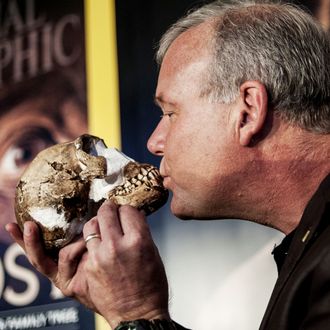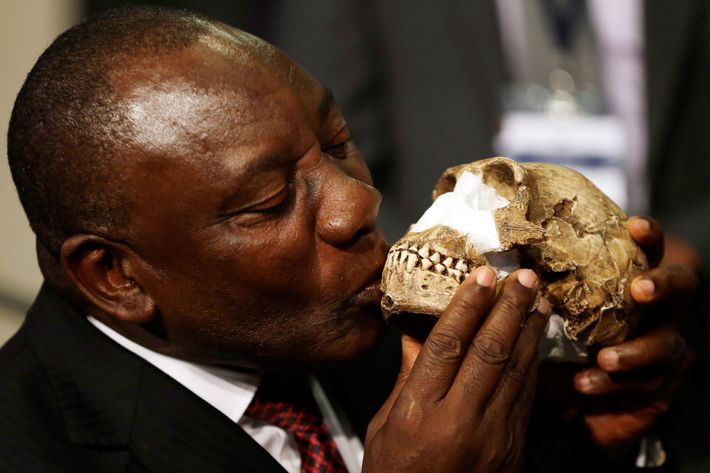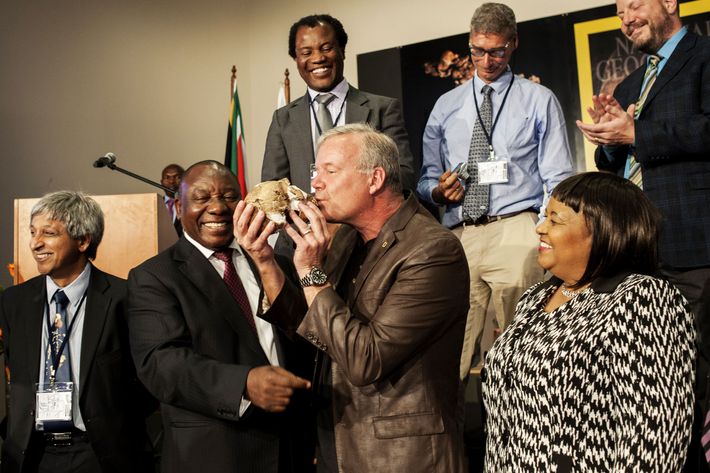
In a cave called Rising Star in South Africa, American paleoanthropologist Lee Berger and his team found more than 1,000 bones and bone fragments from at least 15 individuals — children, babies, adults, and the elderly — from a new, never-before-seen species over the past two years.
Homo naledi — naledi means “star” in Sesotho — appears to be a previously undiscovered skinny human ancestor, about five feet tall, with modern-looking toes and teeth, a very small brain, and legs meant to travel long distances. This discovery seems far more humanlike than upright-walking “Lucy,” from the genus Australopithecus, who lived around 3.2 million years ago.
Given the number of bones in the cave, scientists think Homo naledi were like humans in one other crucial, unexpected way — it seems like they could have had a ritualized tradition of disposing of the dead. And given the darkness of the cave, they might have had to use fire to do it — unless there was another entrance the scientists have yet to find, allowing the bones to tumble into the chamber as if through a remains garbage disposal. The team also considered that the individuals found may have died accidentally, after getting trapped in the cave, washed away, or eaten. However, given the pristine condition of the fossils, that made less sense than the species simply burying the dead on purpose.

“We have just encountered another species that perhaps thought about its own mortality, and went to great risk and effort to dispose of its dead in a deep, remote chamber right behind us,” Berger told CNN while standing in front of the cave where he made this giant discovery. “It absolutely questions what makes us human. And I don’t think we know anymore what does.”
He added, “This is like opening up Tutankhamen’s tomb. It is that extreme and perhaps that influential in this stage of our history.” Other scientists are skeptical and think that this isn’t a new species, but simply an older specimen of Homo erectus, another human ancestor. Scientists have had difficulties determining the age of the fossils. Dr. Tracy Kivell, who helped study the fossils, told Wired, “They could be two or three million years old, they could be 100,000 years old. We don’t know. That’s an interesting part of this study.”
The National Geographic Society, which helped with the expedition, was also insanely excited about the discovery. “If we learned about a completely new form of hominin only because a couple of cavers were skinny enough to fit through a crack in a well-explored South African cave, we really don’t have a clue what else might be out there,” executive editor Jamie Shreeve writes in National Geographic magazine’s upcoming issue.

The fossil site was not easy to find. Scientists had to crawl through an opening less than ten inches high to reach it. “So,” according to National Geographic:
Berger put the word out on Facebook: Skinny individuals wanted, with scientific credentials and caving experience; must be “willing to work in cramped quarters.” Within a week and a half he’d heard from nearly 60 applicants. He chose the six most qualified; all were young women. Berger called them his “underground astronauts.”
“This stuff is like a Sherlock Holmes mystery,” Bernard Wood at George Washington University told the National Post.





























